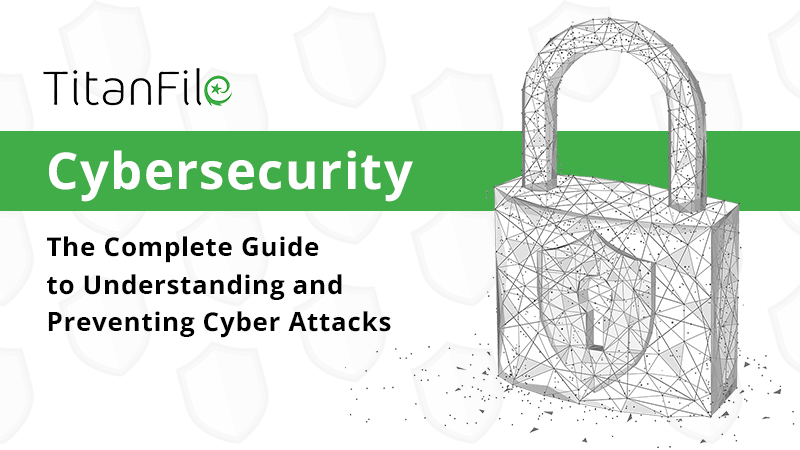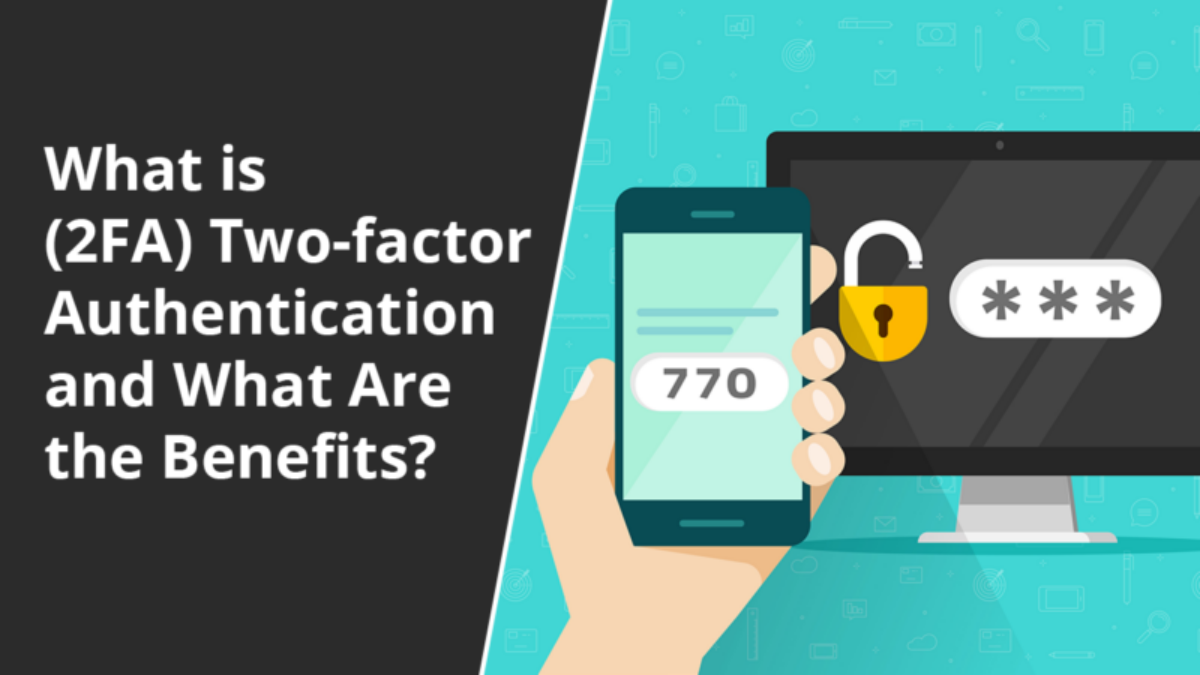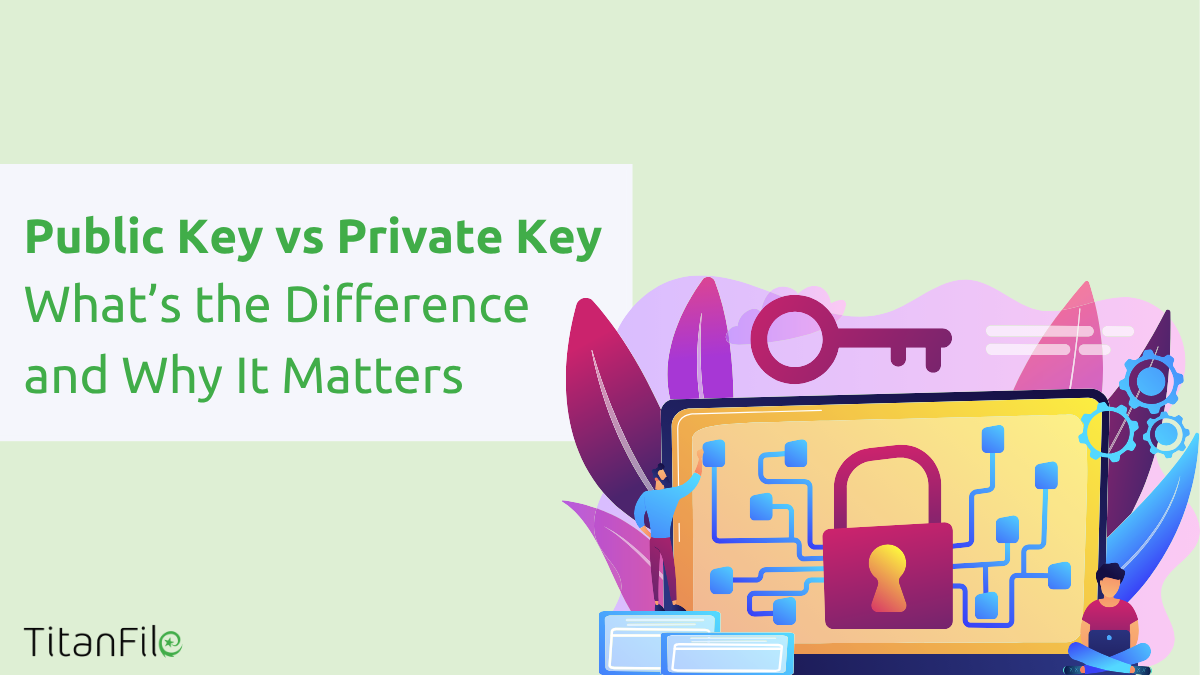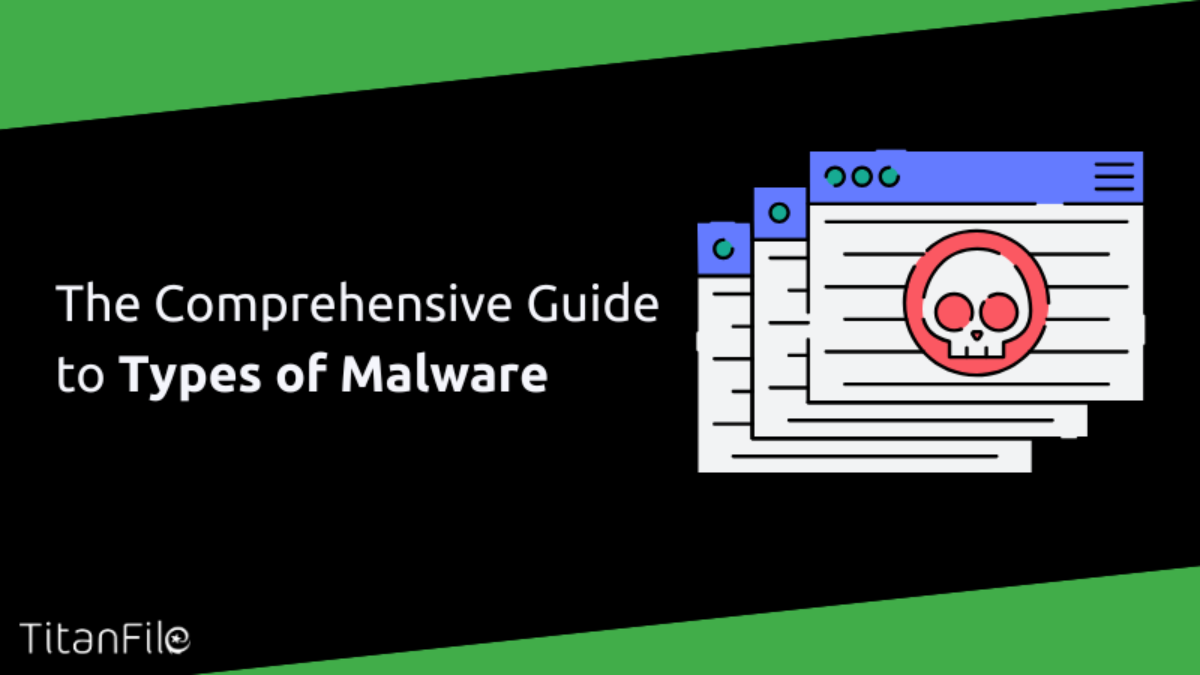Table of Contents
What is Cybersecurity?
Cybersecurity is an overarching term that describes the practice of protecting systems, networks, and data from cyber attacks. These attacks are typically aimed at stealing or altering sensitive information, damaging hardware or software, or causing service disruptions.
Why is cybersecurity important?
The need for cybersecurity is only going to expand as there are more people, devices, and software applications in today’s businesses, along with an abundance of data—many of them sensitive or confidential. The issue is made worse by the increase in the number, level of skill, and variety of cyber attackers and attack methods.
To learn more, read 15 important statistics that show why cybersecurity is important.
The Cost of a Cybersecurity Breach
Experiencing a cybersecurity breach will unravel a series of repercussions that can be broken down into reputational and monetary consequences:
Reputational consequences
It can take years or sometimes decades for a business to build a positive brand reputation. Once built, this reputation is what drives new traffic and enables new customers to trust and remain loyal to the business. However, your reputation can be destroyed in an instant as a result of a cybersecurity breach. A study in 2019 showed that 64% of customers are unlikely to do business with a company that has experienced a sensitive data breach in the past.
Monetary consequences
The costs associated with a data breach have been increasing year over year. As reported by IBM earlier this year, the average cost of a data breach in 2022 is $4.35 million USD. This is a 12.7% jump from $3.86 million USD in 2020. Factored into these costs include the expenses of discovering and responding to the data breach, costs for downtown and lost revenue, and lost business due to reputational damages.
Common Cybersecurity Terms
Before we dive further into cybersecurity, it’s important that you learn some common cybersecurity terms so that you are clear about the context on this page. Here are a few definitions:
- Cloud – software and services that are accessed over the internet rather than locally.
- Software – a set of programs and instructions that tell a computer what to do.
- Authentication – the process of verifying the identity of a user.
- Virtual Private Network (VPN) – encrypts a secure, private network from a public internet connection.
- DDoS Attack – the disruption of normal traffic on a server or network by overwhelming the infrastructure with flooded internet traffic.
- Encryption – the process of encoding plaintext into ciphertext.
- Phishing – a social engineering attack used for stealing users confidential information (i.e. passwords, SSN).
- Exploit – a code that takes advantage of computers security and software vulnerabilities.
- Data Breach – a security incident resulting in stolen information by an unauthorized user.
- Firewall – a network security system which is designed to block unauthorized access and permits outbound communications.
- Malware – malicious software is a file or code designed to exfiltrate data from computer servers.
- Virus – malicious code written to alter how computers operate with the intent to spread between computers and harm data.
- Ransomware – a malicious software designed to block access to a computer system unless a sum of money is paid.
Cybersecurity Myths
Cybersecurity awareness is critical for every organization. However, it’s important to be aware of the facts, not the myths.
When it comes to cybersecurity, there are several myths that could render your entire cybersecurity infrastructure ineffective. Even some of the top Information Security Officers (ISOs) get caught up in believing them.
Some cybersecurity myths include:
1. Only IT is responsible for cybersecurity
The reality: While it’s the Information Security Team’s responsibility to research and learn about new threats and implement the necessary security protocols, it’s not possible for the team to micromanage and control all employees’ decisions.
All employees should be aware of and contribute to the organization’s cybersecurity plan by following best practices and complying with the organization’s security policies.
2. You can be “secure enough”
The reality: Those who believe that they’re secure enough, are the ones that are most vulnerable.
Technology is constantly evolving and so should your cybersecurity. As you adopt new technologies, it’s only natural that they may bring new vulnerabilities with them. Hackers are constantly targetting businesses of all sizes and getting more inventive with their strategies for exposing these vulnerabilities.
3. All you need is a good anti-virus to prevent cyber attacks
The reality: Solely relying on anti-virus will not keep you secure. These programs are designed to detect and quarantine threats that are known, but not threats that have yet to be discovered. Nonetheless, it’s good to know what types of malware exist and how to protect yourself from them.
A good cybersecurity strategy has multiple layers which include anti-virus and a combination of other tools, procedures, and policies.
4. Cyberthreats only come from external sources
The reality: As a matter of fact, the biggest cybersecurity threat to an organization is the staff itself. A vast majority of cybersecurity incidents are a result of employees who have made a mistake because they weren’t properly trained to deal with cyber threats. Granted, rogue employees may also purposely steal information or leak it to unauthorized parties.
5. Complex passwords will keep your data secure
The reality: A good password cracking software is capable of trying billions of different password combinations in seconds. This means even if you use complex passwords for your accounts, it’s still possible for a hacker to break through and access your data. In addition to creating strong passwords, you should also enable two-factor authentication for your devices.
6. Staff will never fall for a phishing attack because they’re too obvious
The reality: Cybercriminals are now creating emails that look almost identical to the ones sent by legitimate companies. It’s easier than ever for employees to be tricked by these emails and accidentally hand over confidential data.
What is a Cyber Attack?
A cyber attack is a series of acts carried out by cyber criminals in an effort to obtain access without authorization, steal data, or harm computers, computer networks, or other computing systems.
Common Cyber Threats
As secure as your business may be, there will always be threats to your security infrastructure and the data it is designed to protect. Some of the most common cyber threats in 2022 include:
1. Inadequate Training for Employees
The biggest cybersecurity threat to organizations comes from within them. According to a recent study by Stanford University, employee errors, whether intentional or accidental, are to blame for 88% of data breach occurrences. Data breaches by employee error can be attributed to a lack of security training by organizations.
2. Misuse of the internet of things (IoT)
The Internet of Things (IoT) is a term used to describe how millions of devices from all around the world connect to the internet. This provides for a network of connected devices that can store, transmit, and receive data. Many people and organizations are utilizing this developing technology as a result of its convenience. However, what’s convenient for you is also convenient for cyber attackers. The interconnectedness that IoT provides also allows hackers easier access to your information when misused.
3. Social Engineering
Social engineering attacks utilize social interactions to obtain access to critical information and deception is at the heart of every attack. Cybercriminals use deception and guile to get their targets to divulge personal information, bypass security protections and reveal vital data. Social engineering attacks usually take the form of phishing (i.e. sending emails with malicious links), baiting (i.e. leaving tampered devices in public to lure people into checking them out), and scareware (i.e. scaring users into buying infected software with false alarms).
4. Mishandling Patches
Outdated software is one of the most common sources of attacks. Why? Because outdated software creates a weak link in device systems and leaves data non-secure and susceptible to attackers. As a result, firms and organizations are vulnerable to any number of information security breaches as long as they do not keep their software up-to-date.
5. Third-Party Vulnerability
Every business uses third-party services, whether it’s payment processing for merchants, financial consultants, or secure file-sharing providers. It’s difficult to run a business smoothly without them. Although third-party services are beneficial to companies, many underestimate the vulnerabilities that come with them and how they can affect their business. It’s not uncommon to hear third-party vendors have fallen victim to cybersecurity breaches.
6. Cloud Vulnerabilities
It’s simple- the more we rely on the cloud for data storage, the greater the chance of a major data breach. The use of cloud storage has skyrocketed over the past few years, and as more confidential information is uploaded to the cloud, the more insistent cyber attackers are on finding a way to exploit it. Cloud services are vulnerable to a variety of cyberattacks, including account takeover and Denial of Service (DoS) attacks, which prevent businesses from accessing their data.
7. Ransomware
Ransomware is considered to be one of the biggest cyber security threats in 2022 and poses a serious cyber threat to businesses of all sizes. Ransomware attacks work by infecting your network and locking down your data and computer systems until a ransom is paid to the hacker. These cyberattacks not only result in financial losses for businesses but data loss and productivity waste too. Depending on the longevity of the attack, the loss of business opportunities due to inaccessibility to data can be harmful to a company’s bottom line.
8. Insufficient Command Over Cyber Risk Management
Businesses frequently neglect to use some of the most effective tools against cyber security threats such as two-factor authentication (2FA), endpoint security, and cloud-based solutions with automatic file encryption. This is a big oversight considering these protections are extremely efficient at lowering the risk for popular cyber attacks like phishing and social engineering.
9. Misinterpreting Compliance for Security
Simply meeting compliance requirements is not the same as maintaining effective security policies and practices year-round. For example, today, the gold standards in compliance for security are ISO 27001 and SOC 2 Type II. However, many companies may have gotten certified for complying with these standards during an audit, but don’t follow the guidelines afterwards.
10. Out-of-Date Hardware
One of the easiest ways for cybercriminals to hack SMBs and Enterprise businesses is through outdated hardware. Why? Because when the hardware is out-of-date it does not have the newest software with security patches which makes it vulnerable to security holes that hackers love to exploit.
How to Improve Cybersecurity
All organizations, no matter how secure, can fall victim to a cyber attack. Considering that there are more than 2,200 cyber attacks per day, it’s only a matter of time before your organization may experience a breach.
As technology advances, cybercriminals also become more creative in their security penetration methods. It’s necessary for your organization’s information security infrastructure to evolve as well as to be able to defend against these threats.
Here are some ways you can improve cybersecurity at your organization.
Complying with Industry Regulations
As a professional organization, there is likely a set of standards and regulations you need to follow. For example, healthcare providers in the United States are required to follow the HIPAA regulation to keep patient health information (PHI) confidential. Canadian companies are required to comply with the PIPEDA regulation.
Abiding by the policies and procedures set out by the standards and regulations in your industry is an excellent place to start improving your cybersecurity posture because they provide a structured approach to keeping data secure.
Some other common standards and regulations include:
Data Encryption
Data encryption is a process by which readable data is converted to an encoded format. When information is encrypted, even if it were stolen, cybercriminals would not have access to the data without the encryption keys; they wouldn’t be able to utilize the information. This makes data encryption one of the most effective ways of improving cybersecurity.
Learn more about data encryption and why it’s important.
Other cybersecurity best practices:
- Keep software and hardware up to date
- Avoid opening suspicious emails
- Use secure file sharing software to encrypt data
- Install anti-virus and anti-malware
- Use a VPN to privatize your connections
- Check links before you click
- Use strong passwords
- Disable Bluetooth when not using it
- Enable multi-factor authentication
- Remove adware from your devices
- Double-check for HTTPS when visiting websites
- Don’t store information in non-secure places
- Scan external devices for viruses
- Avoid using public networks
- Avoid the “secure enough” mentality
- Invest in ongoing security upgrades
- Back up important data
- Train employees on security policies
- Use HTTPS on your website
- Employ a penetration testing company / White Hat hacker
Some additional resources to help improve cybersecurity and data privacy:
Who is Responsible for Managing Cybersecurity?
A common misconception is that cybersecurity is solely the responsibility of the IT team, when in fact, the entire organization plays a role in an effective cybersecurity strategy. According to the 2022 WEF Global Risks Report, 95% of cybersecurity issues are traced back to human error. This means that all it takes is one employee to make a mistake for a data breach to occur.
While the IT team plays a major role in security training for staff in an organization, it’s up to the employees themselves to consciously execute best practices and follow the organization’s security policies.
The IT team should set a routine schedule for cybersecurity awareness and training to keep the entire organization up-to-date with cybersecurity risks and to help maintain a cybersecurity culture.
How Much to Spend On Cybersecurity
International Accounting Firm, Deloitte, reported in 2020 that companies on average spend between 6% to 14% of their annual IT budget on cybersecurity. This budget will vary depending on the size of your organization, what you need to protect, what regulations you need to abide by, and what services and tools you decide to use.
It’s good practice to do some research to see how much other companies in your industry are investing in cybersecurity and what they are spending their money on.
Creating a Cybersecurity Risk-Management Plan
A cybersecurity risk-management plan is something that organizations of all sizes should implement. A study in 2021 revealed that there were more than 1,862 data breaches that took place in 2021, a 68% increase from 2020. Regardless of whether your business feels it’s necessary at to create a plan, it never feels essential until it’s too late, by which at this point, you’re scrambling to mitigate damages.
Creating a cybersecurity risk-management plan consists of 4 steps:
1. Identifying risks
Identifying current and potential threats that may affect your organization’s cybersecurity infrastructure and business operations.
2. Assessing the risks
Analyzing the identified risks to determine their priority levels (i.e. low risk to critical risk) and their potential impact.
3. Addressing the risks
Breaking down the methods, procedures, and technologies necessary to address the analyzed risks.
4. Monitoring and reporting
Reporting on risk findings and effectiveness of mitigation efforts, and consistently monitoring and adjusting the management plan as needed.
Learn how to create an effective cybersecurity risk-management plan.
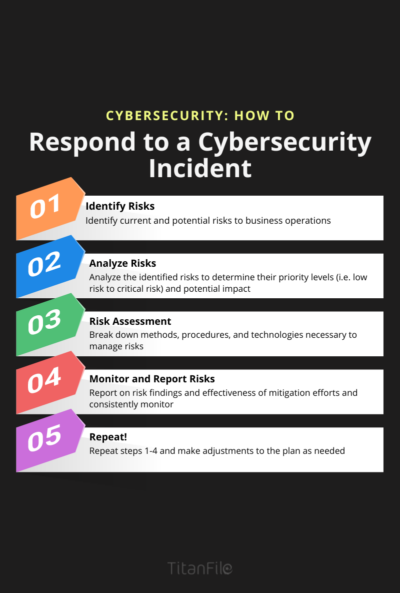
Responding to a Cybersecurity Incident
Let’s face it, if your organization has yet to experience a data breach, it’s only a matter of time before one occurs.
No matter the size of your organization, you should always be prepared for the worst. To be as prepared as possible, ensure that you have a Cybersecurity Incident Response Plan that is ready to execute at any given moment.
What is a Cybersecurity Incident Response Plan?
A Cybersecurity Incident Response Plan is a ready-to-go set of tools and procedures that an organization is to follow in the case of a cybersecurity incident. The plan is designed for your organization to effectively control and mitigate further damages caused by the incident by reducing the spread of the breach, avoiding data loss or theft, and reducing the overall downtime of the organization.
A good Cybersecurity Incident Response Plan consists of 6 stages:
1. Preparation
The preparations stage is the most critical of all f the stages. Preparation involves understanding what kinds of threats exist and preparing your entire team to be ready to handle them. This includes having clear policies and guidelines for staff to follow and having a communication plan.
2. Identification
In this stage, your team should identify the size and scope of the incident, starting with the initial compromised device, known as “patient zero.” From there, you can use monitoring tools to identify the root cause of the incident.
3. Containment
The containment stage involves a series of steps to prevent the further spread of the incident by isolating compromised devices from the rest of the network.
4. Eradication
When the incident is contained, you can now begin to eradicate the issue. In many cases, you may need to hire third-party professional services to help resolve security issues.
5. Recovery
In the recovery stage, you can begin to take the steps necessary to restore your services and devices and become completely operational again.
6. Post-Mortem of the Incident
Every part of the incident and the recovery process should be well-documented with steps taken and lessons learned. These notes will enable you to prevent future attacks and also help with faster response times.
